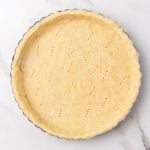
Italian Pasta Frolla (pie crust for crostata and galette)
This is an Italian Sweet Pie Crust known as pasta frolla. Perfect for making crostatas and galettes. It is a simple and rich dough used in many traditional recipes. It can be made-ahead as it freezes wonderfully!
Servings 1 9-inch pie
Ingredients
For the dough:
- 2 ¼ cups all-purpose flour
- ½ teaspoon baking powder
- ½ cup sugar
- pinch of salt
- ¾ cup unsalted butter cold and in pieces
- 1 egg
- 1 egg yolk
Instructions
For the dough:
- If using a food processor, pulse a few times to mix 2 ¼ cups all-purpose flour, ½ teaspoon baking powder, ½ cup sugar and a pinch of salt. Scatter ¾ cup unsalted butter, cold and in small pieces on top, and mix until you have butter the size of peas.
- If making it by hand, stir to mix 2 ¼ cups all-purpose flour, ½ teaspoon baking powder, ½ cup sugar and pinch of salt in a large bowl. Scatter ¾ cup unsalted butter, cold and in small pieces on top and mix until you have butter the size of peas.
- For both methods, add 1 egg and 1 egg yolk and process using quick on/off pulses, or stir with a fork, until it all starts to come together. If processing it, don’t let it form a ball. If you take a little and squeeze it with your hand or pinch it with your fingers, it should come together.
- Turn it onto the counter and gather it together several times, pressing it to form a rather smooth dough ball. Don't overwork it, or the crust will be tough when you bake it. The butter must remain cold. I put it inside a plastic bag and aid myself with the bag while pressing my knuckles until it comes together. That way, I don’t touch the dough unnecessarily.
- Press the dough into a flat disk. Cover with plastic wrap and refrigerate for 1 hour and up to 3 days.
Notes
Butter, have it cold and in pieces. This is very important so it mixes a bit with the flour but is not completely incorporated into it. Some pieces of butter the size of peas should remain in order to ensure flakiness when it is baked. I use a food processor for this part, but you can easily make it in a bowl with a dough cutter or use your hands.
Don't overwork the dough after adding the flour. This is a critical step if you want a tender, light dough. Once the flour is added, don't overwork it, it doesn't need to be kneaded. It needs to be mixed until there are no visible streaks of flour. Be careful not to overwork the butter and start to soften it too much (due to warm hands). If that happens, return it to the fridge for 10-15 minutes, and then continue.
Always let it rest in the fridge before rolling it. This step is absolutely essential. The dough, even if you didn't work it much when assembling it, will have developed some gluten (great for bread for example but not for doughs), so it needs to relax in the cold refrigerator before it is rolled. Otherwise, it will be difficult to stretch and will be too elastic, which will make it shrink as it bakes and be tough.
Refrigerating: after you make the dough ball, wrap it well and keep it in the fridge for up to a week. Make sure no part of the dough is left unwrapped as it will dry out. I wrap it in double plastic or in a freezer paper and then in a Ziploc bag.
Freezing: follow the same wrapping procedure as for the refrigerator. Make sure you label and date it. It can be frozen for about two months.